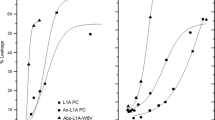Abstract
Purpose. The objective of this work is to understand the sequence specificity of HAV peptides and to improve their selectivity in regulating E-cadherin-E-cadherin interactions in the intercellular junctions.
Methods. Peptide 1 was modified using an alanine scanning method to give peptides 2-6. The ability of these peptides to modulate intercellular junctions was evaluated using Madin-Darby Canine Kidney (MDCK) cell monolayers on Transwell™ membranes from either the apical (AP) or the basolateral (BL) side. Modulation of the intercellular junctions was measured by the ability to lower the transepithelial electrical resistance (TEER) of MDCK monolayers and by the increase in mannitol flux. Molecular docking experiments were performed to model the binding properties of these peptides to the EC1 domain of E-cadherin.
Results. Peptides 5 (Ac-SHAVAS-NH2) and 6 (Ac-SHAVSA-NH2) were found to be more effective than the parent peptide 1 in decreasing the resistance of the cell monolayer. Furthermore, comparative studies with the control and the weak inhibitor peptide 2 indicate that peptide 5 displayed a significant increase in mannitol flux. Molecular docking of peptides 1, 2 and 5 to the EC1 domain suggests that peptide 5 has the lowest binding energy.
Conclusions. HAV peptides have the ability to modulate E-cadherin-E-cadherin interactions in the intercellular junctions of the MDCK cell monolayer, thus indirectly increasing the permeability of the tight junctions. This observation indicates that residues flanking the HAV sequence are important in the binding selectivity of HAV peptides to E-cadherin. Molecular docking can further aid in the design of peptides with better selectivity to the EC1 domain of E-cadherin.
Similar content being viewed by others
REFERENCES
A. Adson, T. J. Raub, P. S. Burton, C. L. Barsuhn, A. R. Hilgers, K. L. Audus, and N. F. H. Ho. Quantitative approaches to delineate paracellular diffusion in cultured epithelial cell monolayers. J. Pharm. Sci. 83:1529-1536 (1994).
M. Takeichi. Morphogenetic roles of classic cadherins. Curr. Opin. Cell. Biol. 7:619-627 (1995).
J. Behrens. Cadherins as determinant of tissue morphology and suppressors of invasion. Acta Anat. 149:165-169 (1994).
J. A. Marrs and W. J. Nelson. Cadherin cell adhesion molecules in differentiation and embryogenesis. Int. Rev. Cytol. 165:159-205 (1996).
B. Z. Katz, S. Levenberg, K. M. Yamada, and B. Geiger. Modulation of cell-cell adherens junctions by surface clustering of the N-cadherin cytoplasmic tail. Exp. Cell. Res. 243:415-424 (1998).
J. R. Alattia, H. Kurokawa, and M. Ikura. Structural view of cadherin-mediaed cell-cell adhesion. Cell. Mol. Life Sci. 55:359-367 (1999).
M. Overduin, T. Harvey, S. Bagby, K. Tong, P. Yau, M. Takeichi, and M. Ikura. Solution structure of the epithelial cadherin domain responsible for selective cell-adhesion. Science 267:386-389 (1995).
B. Nagar, M. Overduin, M. Ikura, and J. M. Rini. Structural basis of calcium-induced E-cadherin rigidification and dimerization. Nature 380:360-364 (1996).
A. W. Koch, D. Bozic, O. Pertz, and J. Engel. Homophilic adhesions by cadherins. Curr. Opin. Struc. Biol. 9:275-281 (1999).
M. Cereijido, E. S. Robbins, W. J. Dolan, C. A. Rotunno, and D. D. Sabatini. Polarized monolayers formed by epithelial cells on a permeable and translucent support. J. Cell Biol. 77:853-880 (1978).
M. Takeichi. Cadherins: A molecular family important in selective cell-cell adhesion. Annu. Rev. Biochem. 59:237-252 (1990).
A. Nose, K. Tsuji, and M. Takeichi. Localization of specificity determining sites in cadherin cell adhesion molecules. Cell 61: 147-155 (1990).
O. W. Blaschuck, R. Sullivan, S. David, and Y. Poulliot. Identification of a cadherin cell adhesion recognition sequence. Develop. Biol. 139:227-229 (1990).
G. Mbalaviele, H. Chen, B. F. Boyce, G. R. Mundy, and T. Yoneda. The role of cadherin in the generation of multinucleated osteoclasts from mononuclear precursors in murine marrow. J. Clin. Invest. 95:2757-2765 (1995).
I. T. Makagiansar, E. Sinaga, A. Calcagno, C. Xu, and T. J. Siahaan. Roles of E-cadherin and β-catenin in cell adhesion, signaling and possible therapeutic applications. Curr. Top. Biochem. Res. 2:51-61 (2000).
K. L. Lutz and T. J. Siahaan. Modulation of the cellular junction protein E-cadherin in bovine brain microvessel endothelial cells by cadherin peptides. Drug Deliv. 4:187-193 (1997).
D. Pal, K. L. Audus, and T. J. Siahaan. Modulation of cellular adhesion in bovine microvessel endothelial cells by a decapeptide. Brain Res. 747:103-113 (1997).
K. L. Lutz, D. Pal, K. L. Audus, and T. J. Siahaan. Inhibition of E-cadherin-mediated cell-cell adhesion by cadherin peptides. In J. P. Tam and P. T. P. Kaumaya (eds.), Peptides: Frontiers of Science, Kluwer/Escom, Boston, 1999 pp. 753-754.
K. L. Lutz and T. J. Siahaan. E-cadherin peptide sequence recognition by an anti-E-cadherin antibody. Biochem. Biophys. Res. Commun. 211:21-27 (1995).
G. M. Morris, D. S. Goodsell, R. Huey, and A. J. Olson. Distributed automated docking of flexible ligands to proteins: Parallel applications of AutoDock 2.4. J. Comput.-Aided Mol. Des. 10: 293-304 (1996).
J. L. Madara. Regulation of the movement of solutes across tight junctions. Annu. Rev. Physiol. 60:143-159 (1998).
J. M. Staddon, K. Herrenknecht, C. Smales, and L. L. Rubin. Evidence that tyrosine phosphorylation may increase tight junction permeability. J. Cell. Sci. 108:609-619 (1995).
W. C. Prozialeck and P. C. Lamar, Cadmium disrupts E-cadherin-dependent cell-cell junctions in MDCK cells. In Vitro Cell Dev. Biol. Anim. 33:512-526 (1997)
S. Potempa and A. J. Ridley. Activation of both MAP kinase and phosphatidylinositide 3-kinase by ras is required for hepatocyte growth factor/scatter factor-induced adherens junction disassembly. Mol. Biol. Cell 9:2185-2200 (1998).
I. S. Nathke, L. Hinck, J. R. Swedlow, J. Papkoff, and W. J. Nelson. Defining interactions and distributions of cadherin and catenin complexes in polarized epithelial cells. J. Cell Biol. 125: 1341-1352 (1994).
F. Cao and J. M. Burke. Protein insolubility and late-stage morphogenesis in long-term postconfluent cultures of MDCK epithelial cells. Biochem. Biophys. Res. Commun. 234:719-728 (1997).
Author information
Authors and Affiliations
Rights and permissions
About this article
Cite this article
Makagiansar, I.T., Avery, M., Hu, Y. et al. Improving the Selectivity of HAV-Peptides in Modulating E-Cadherin-E-Cadherin Interactions in the Intercellular Junction of MDCK Cell Monolayers. Pharm Res 18, 446–453 (2001). https://doi.org/10.1023/A:1011094025008
Issue Date:
DOI: https://doi.org/10.1023/A:1011094025008




